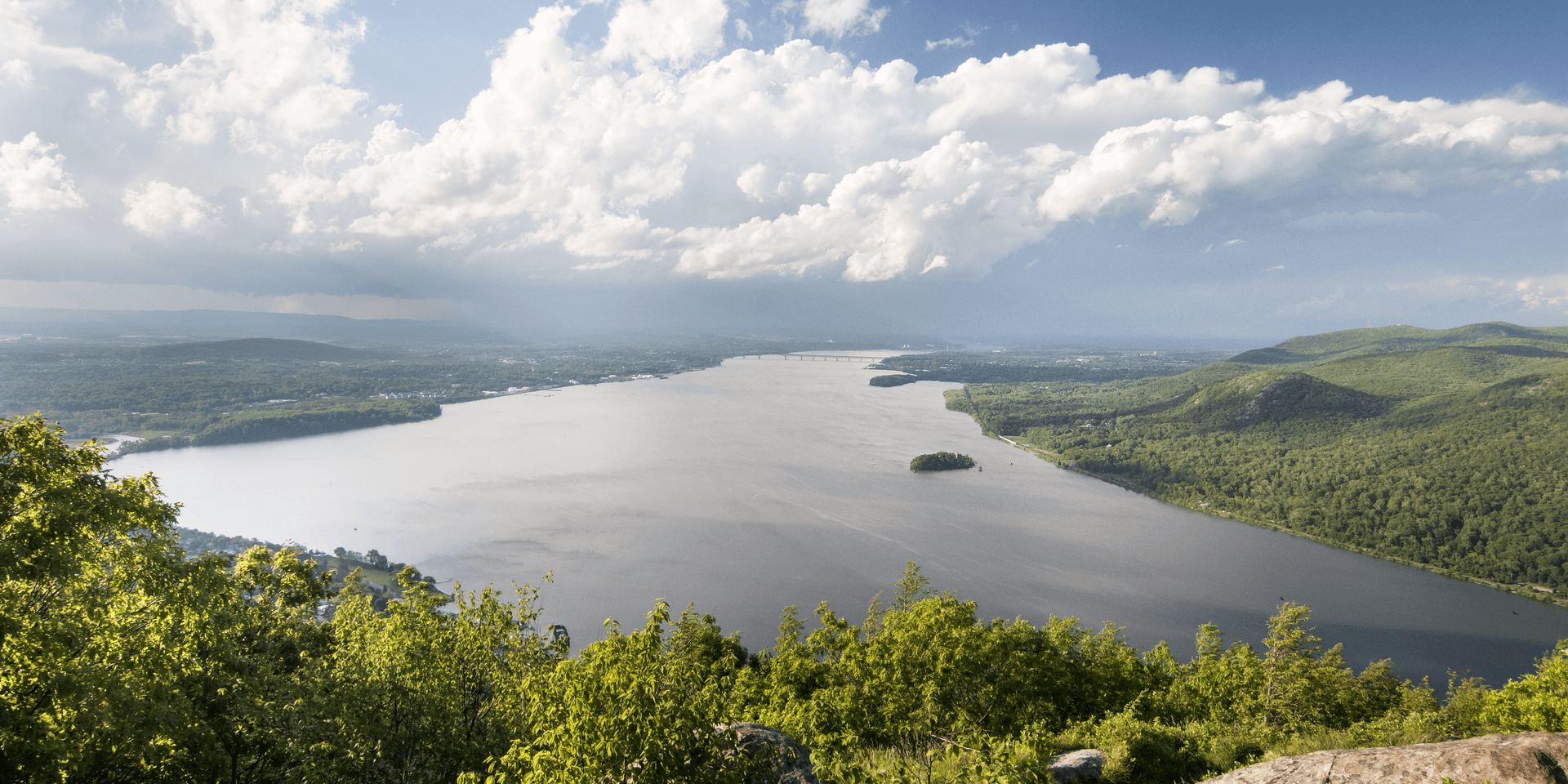You are here
Storm King Mountain (1,340 feet) is the cornerstone of Storm King State Park, a 1,972-acre area located on the west bank of the Hudson River in Cornwall-on-Hudson. The steep sides and rounded tops of these mountains, carved out by the last ice age, create a significant bend in the river marking the beginning of a fjord that stretches south to West Point and Bear Mountain State Park. The Stillman (Yellow) and Bluebird (Red/Blue) trails form a 3-mile loop with an approximately 1,000-foot gain that climbs to the peak and circles the summit. You’ll be delighted by expansive views of the entire Hudson Valley from Hudson Highlands State Park to the east, the North Ridge and Constitution Island to the south, the Shawangunk Ridge to the northwest, and beyond to the Catskill Mountains. Scenic Hudson, a land conservancy group, has a published map of the area to help you navigate your route.
The trailhead is on Mountain Road in Cornwall-on-Hudson. There is a kiosk and a small dirt parking area in front of an old stone gateway. Follow the old estate road through the woods, over bridges, and up the mountain. You’ll pass the Highlands Trail on your left, a newer cooperative venture from the New York-New Jersey Trail Conference beginning at the Riverfront Park at Cornwall Landing and extending 150 miles to Riegelsville, New Jersey, on the Delaware River.
Within a short distance, the yellow markers will lead off of the wide road and onto the northern mountain face. You’ll continue a gradual ascent to a trail split with the Bluebird Trail (Red/Blue). From this junction, there is a spring (not potable) in a small stone structure. A little farther into the woods you can see the foundation of an old water retaining structure to hold and control water flow for power generation. Return to the junction and proceed up the Stillman Trail (Yellow) to the left.
The trail will travel along the steep mountainside, climbing higher and higher above the Hudson River. This is one of the steeper trails in the park, and there are some wooden steps and bridges to help you over some difficult gaps. Be mindful of slippery rocks and occasional rock slides. As you approach the top, the trail will wrap around to the mountain’s south side with panoramic views of North Point and Pitching Point as well as Mount Taurus across the river. You’ll come to the White Bypass Trail, but keep right and follow the yellow markers that lead right and up to the summit. Once at the top, the tree cover will open with expansive views of the Hudson Valley to the north. The Newburgh-Beacon Bridge spans almost 2 miles across the river where you’ll see large barges and tugboats. Bannerman’s Castle on Pollepel Island is far below, and across the water you’re likely to see small specks of hikers on Breakneck Ridge. After you’ve enjoyed some of the most spectacular views in the Hudson Valley, follow the yellow markers for another half-mile to the Bluebird Trail on your right. Follow this path as it descends down the mountain and returns to the junction near the old spring.
Storm King Mountain defines the park with a monumental, jagged rock face that wraps around its eastern side. At 1,340 feet in elevation, it can easily be identified along the horizon, even from miles away to the north, with its signature dip into the Hudson River. While Henry Hudson and his crew called the mountain Klinkesberg, the name was never kept. The name Storm King comes from 19th-century writer Nathaniel Parker Willis, who referred to the fog clouds that regularly bottleneck here in the early morning hours. New York State Route 218, also known as Old Storm King Highway, cuts into the mountainside extending from Highland Falls in the south to Cornwall-on-Hudson in the north and creates an awe-inspiring route along the Hudson with several spots to pull over and marvel at the scenery.
In the 1960s this mountain was under the threat of development by Consolidated Edison. At that time, they had plans to build a large pumped-storage power plant with a powerhouse at the base of the mountain, 10-story transmission towers running power lines across the river, and a 260-acre reservoir in the Black Rock Forest. In response, the public came together to form the Scenic Hudson Preservation Conference and protect the mountain’s natural beauty and resources. Joined by the Nature Conservancy, the NY-NJ Trail Conference, the Natural Resource Defense Council, and the Hudson River Fishermen’s Association, they contested the project and negotiated a settlement in December of 1980. The result of these efforts was the start of a national movement that became the basis for U.S. environmental law as well as an inspiration for public environmental coalitions throughout the country.
Logistics + Planning
Current Weather: Powered by Dark Sky






























Comments
Sign In and share them.